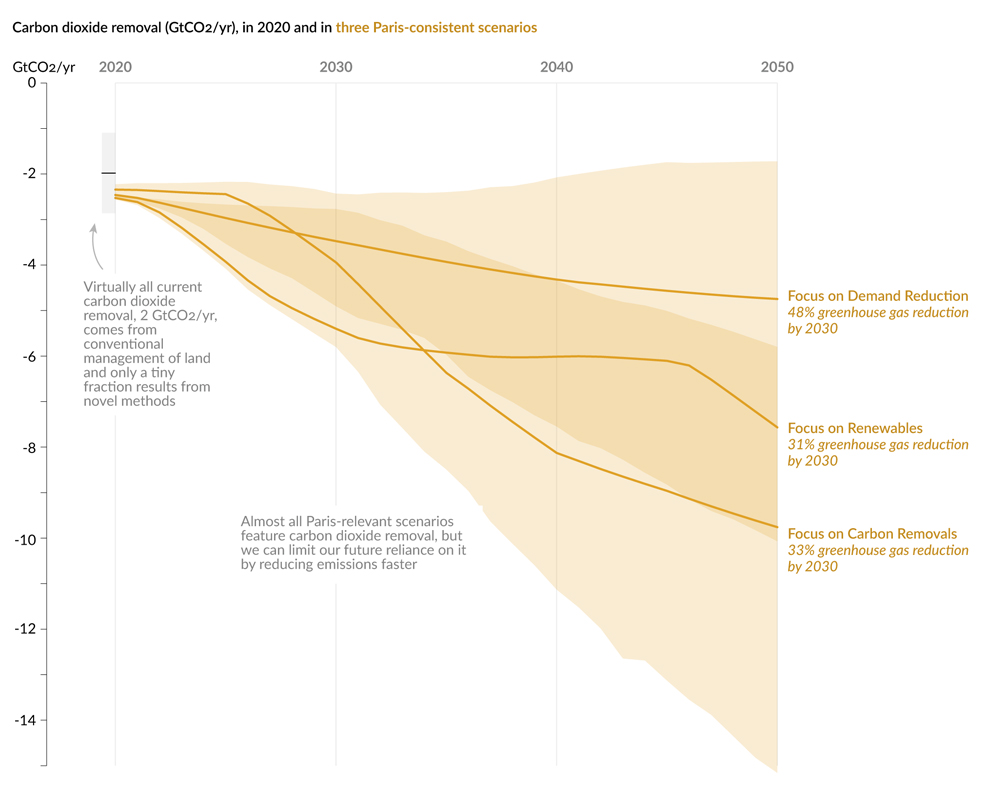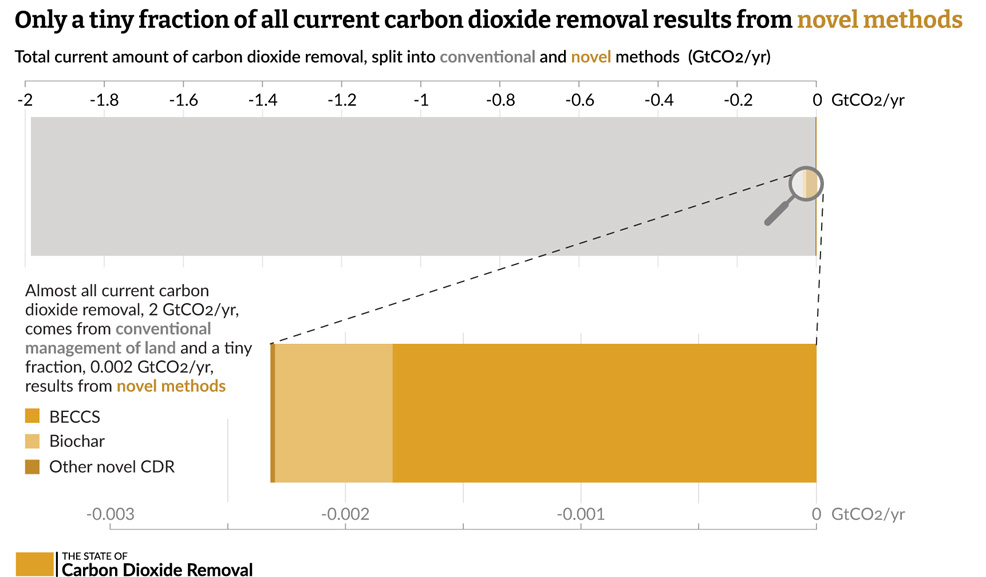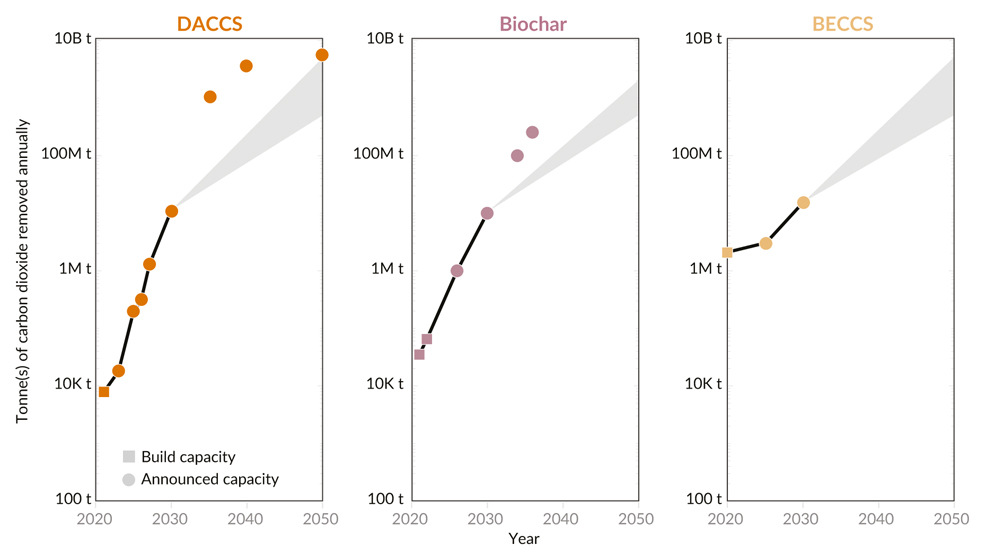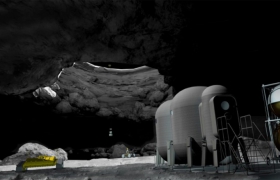- Luật
- Hỏi đáp
- Văn bản pháp luật
- Luật Giao Thông Đường Bộ
- Luật Hôn Nhân gia đình
- Luật Hành Chính,khiếu nại tố cáo
- Luật xây dựng
- Luật đất đai,bất động sản
- Luật lao động
- Luật kinh doanh đầu tư
- Luật thương mại
- Luật thuế
- Luật thi hành án
- Luật tố tụng dân sự
- Luật dân sự
- Luật thừa kế
- Luật hình sự
- Văn bản toà án Nghị quyết,án lệ
- Luật chứng khoán
- Video
- NGHIÊN CỨU PHÁP LUẬT
- ĐẦU TƯ CHỨNG KHOÁN
- BIẾN ĐỔI KHÍ HẬU
- Bình luận khoa học hình sự
- Dịch vụ pháp lý
- Tin tức và sự kiện
- Thư giãn

TIN TỨC
fanpage
Thống kê truy cập
- Online: 223
- Hôm nay: 198
- Tháng: 1621
- Tổng truy cập: 5245625
Loại bỏ CO2 cần tăng 1.300 lần vào năm 2050 CO2 removal needs 1,300x increase by 2050
Đánh giá toàn cầu, toàn diện đầu tiên về loại bỏ carbon dioxide (CDR) – bao gồm cả những phát triển hiện tại và xu hướng dự kiến trong tương lai – đã được Đại học Oxford công bố trong tuần này.xu hướng loại bỏ carbon 2050
Phân tích chi tiết cho thấy rằng các phương pháp tự nhiên (chẳng hạn như phục hồi cây và đất) sẽ cần tăng gấp đôi, trong khi các công nghệ mới như thu khí trực tiếp cần tăng công suất gấp 1.300 lần vào năm 2050.Năng lượng tái tạo đã đạt được những tiến bộ vượt bậc trong những năm gần đây – đặc biệt là năng lượng mặt trời và năng lượng gió, thường vượt quá dự báo của các nhà phân tích trong ngành.Tuy nhiên, ngay cả với sự phát triển nhanh chóng của những công nghệ này và các công nghệ sạch khác, thế giới vẫn có khả năng bỏ lỡ các mục tiêu giảm phát thải hiện tại.Để đảm bảo một tương lai bền vững, cần có thêm các chiến lược dài hạn.Điều này bao gồm việc tăng quy mô thu hồi và lưu trữ carbon một cách đáng kể.Báo cáo "Tình trạng Loại bỏ Carbon Dioxide" đầu tiên hiện đã được công bố rộng rãi.Đại học Oxford đã triệu tập hơn 20 chuyên gia trong lĩnh vực CDR để đưa ra một bức tranh hoàn chỉnh về tiến độ mới nhất, cùng với các kịch bản tiềm năng cho thế kỷ 21, tùy thuộc vào phương pháp nào được sử dụng và mức độ cam kết của các doanh nghiệp và chính phủ.Theo báo cáo, hầu hết tất cả CDR hiện nay đều đến từ các phương pháp loại bỏ thông thường trên đất (2 GtCO2 mỗi năm), chủ yếu thông qua việc trồng cây và quản lý đất.Các quốc gia sẽ cần duy trì và mở rộng điều này, tăng khoảng gấp đôi trong lộ trình 1,5°C và tăng khoảng 50% trong lộ trình 2°C vào năm 2050 so với mức của năm 2020.Các tác giả cho biết đây sẽ là một thách thức lớn, đòi hỏi các chính sách và quản lý chuyên dụng.Ngoài các phương pháp thông thường đó, hầu như tất cả các lộ trình phát thải cũng yêu cầu các công nghệ mới – chẳng hạn như năng lượng sinh học có thu hồi và lưu trữ carbon (BECCS), than sinh học, phong hóa đá tăng cường và thu giữ không khí trực tiếp (DAC).Nhưng hiện tại, chúng chỉ chiếm một phần rất nhỏ trong CDR (0,002 GtCO2 mỗi năm).Thu hẹp khoảng cách CDR đòi hỏi sự phát triển mạnh mẽ của các công nghệ CDR mới này, với hệ số trung bình là 1.300 vào năm 2050.công nghệ loại bỏ carbon dioxide"Để hạn chế sự nóng lên ở mức 2°C hoặc thấp hơn, chúng ta cần tăng cường giảm phát thải. Nhưng những phát hiện của báo cáo này rất rõ ràng: chúng ta cũng cần tăng cường loại bỏ carbon bằng cách khôi phục và tăng cường hệ sinh thái cũng như nhanh chóng nhân rộng các phương pháp CDR mới," Tiến sĩ Steve Smith của Trường Doanh nghiệp và Môi trường Smith của Đại học Oxford giải thích."Nhiều phương pháp mới đang nổi lên đầy tiềm năng. Thay vì tập trung vào một hoặc hai lựa chọn, chúng ta nên khuyến khích một danh mục đầu tư – để chúng ta nhanh chóng đạt được mức 0 ròng mà không cần quá phụ thuộc vào bất kỳ phương pháp nào.""Đổi mới trong CDR đã mở rộng đáng kể trong hai năm qua, được đo bằng đầu tư vào năng lực, nghiên cứu được tài trợ công và bằng sáng chế," đồng tác giả báo cáo, Giáo sư Gregory Nemet giải thích."Nhưng với quy mô lớn mà ngành CDR cần phát triển vào giữa thế kỷ này để hạn chế sự nóng lên, cần có một nhu cầu cấp thiết về hỗ trợ chính sách toàn diện để thúc đẩy tăng trưởng."Hai trong số các công ty hiện đang phát triển công nghệ CDR là Climeworks và Brilliant Planet.Trước đây đã phát triển một cơ sở DAC với công suất loại bỏ 4.000 tấn CO2 mỗi năm, lưu trữ khí vĩnh viễn thông qua quá trình khoáng hóa tự nhiên.Loại thứ hai đang phát triển các hệ thống ao tảo ngoài trời trên vùng đất sa mạc ven biển, có thể tái tạo các bông hoa đại dương theo mùa đôi khi có thể nhìn thấy từ không gian.Các dự án này đang trong giai đoạn thử nghiệm và chỉ giúp giảm thiểu lượng CO2 rất nhỏ so với sản lượng hàng năm của nhân loại.Tuy nhiên, Climeworks và Brilliant Planet đều tuyên bố rằng các khái niệm của họ có tiềm năng to lớn để nhân rộng.Như thể hiện trong hình bên dưới, báo cáo của Đại học Oxford bao gồm tổng số kết hợp của các công ty khác nhau đầu tư vào DACCS, Biochar và BECCS, cho thấy năng lực xây dựng của họ (hình vuông) và kế hoạch mở rộng trong tương lai (hình tròn).Các tác giả báo cáo viết: “Các khu vực được tô bóng cho mỗi phương pháp cho thấy năm ngoái các thông báo về năng lực của công ty có thể phát triển như thế nào để đáp ứng tiềm năng kỹ thuật xã hội của CDR vào giữa thế kỷ”."Các điểm dữ liệu thấp và cao vào năm 2050 thể hiện phạm vi loại bỏ tiềm năng tối đa, phụ thuộc vào giới hạn sinh lý, chi phí kinh tế và tác dụng phụ của việc triển khai."Vì những biểu đồ này ở thang logarit, nên có thể kỳ vọng tiến bộ theo cấp số nhân trong những thập kỷ tới, nếu mọi việc diễn ra theo đúng kế hoạch.DACCS và BECCS đều có tiềm năng loại bỏ tới 5 GtCO2 mỗi năm vào năm 2050, trong khi than sinh học đạt 2 GtCO2 mỗi năm trong trường hợp tốt nhất.Tổng số 12 GtCO2 này sẽ làm giảm đáng kể lượng khí thải hàng năm của nhân loại, hiện ở mức 37 GtCO2 mỗi năm.Kết hợp với giảm phát thải và các phương pháp tự nhiên như phục hồi rừng, cuối cùng nó có thể bắt đầu đảo ngược quá trình tích tụ CO2 kéo dài hàng thế kỷ, mà ngày nay đang tiến gần đến tổng tích lũy gần 2.000 GtCO2 kể từ Cách mạng Công nghiệp.công nghệ loại bỏ carbon dioxide 2050
The first comprehensive, global assessment of carbon dioxide removal (CDR) – including both current developments and projected future trends – has been published this week by Oxford University.

The detailed analysis finds that natural methods (such as tree and soil restoration) will need to double, while new technologies such as direct air capture need a 1,300-fold capacity increase by 2050.
Renewable energy has made excellent progress in recent years – particularly solar and wind power, often exceeding the forecasts of industry analysts. However, even with rapid growth in these and other clean technologies, the world is likely to miss current targets for emission reductions. To ensure a sustainable future, additional long-term strategies are needed. This includes a dramatic scaling up of carbon capture and storage.
The first "State of Carbon Dioxide Removal" report is now publicly available. Oxford University convened more than 20 experts in the field of CDR to produce a complete picture of the latest progress, along with potential scenarios for the 21st century, depending on which methods are used and the level of commitment shown by businesses and governments.
According to the report, almost all current CDR comes from conventional removal methods on land (2 GtCO2 per year), primarily via the planting of trees and management of soils. Countries will need to maintain and expand this, approximately doubling in 1.5°C pathways and increasing by around 50% in 2°C pathways by 2050 compared to 2020 levels. This will be a huge challenge, requiring dedicated policies and management, say the authors.
In addition to those conventional methods, virtually all emission pathways also require new technologies – such as bioenergy with carbon capture and storage (BECCS), biochar, enhanced rock weathering, and direct air capture (DAC). But at present, these make up only a tiny fraction of CDR (0.002 GtCO2 per year). Closing the CDR gap requires massive growth of these new CDR technologies, by a factor of 1,300 on average by 2050.

"To limit warming to 2°C or lower, we need to accelerate emissions reductions. But the findings of this report are clear: we also need to increase carbon removal, too, by restoring and enhancing ecosystems and rapidly scaling up new CDR methods," explains Dr Steve Smith of the University of Oxford's Smith School of Enterprise and Environment. "Many new methods are emerging with potential. Rather than focusing on one or two options, we should be encouraging a portfolio – so that we get to net zero quickly, without over-relying on any one method."
"Innovation in CDR has expanded dramatically in the past two years, as measured by investment in capacity, publicly funded research, and patents," explains report co-author Professor Gregory Nemet. "But given the orders of magnitude the CDR industry needs to grow by mid-century to limit warming, there is an urgent need for comprehensive policy support to spur growth."
Two of the companies now developing CDR technology are Climeworks and Brilliant Planet. The former has developed a DAC facility with 4,000 tons of CO2 removal capacity per year, which stores the gas permanently through a natural mineralisation process. The latter is developing open-air, algae pond-based systems on coastal desert land, which could replicate the seasonal ocean blooms that are sometimes visible from space.
These projects are in the pilot stages, and provide only a miniscule reduction in CO2 compared to the annual output of humanity. However, Climeworks and Brilliant Planet both state that their concepts have enormous potential for scaling up. As shown in the figure below, Oxford University's report includes combined totals for various companies investing in DACCS, Biochar, and BECCS, showing their built capacities (squares) and future expansion plans (circles).
"Shaded areas for each method show how the last year of company capacity announcements could grow to meet CDR socio-technical potential by mid-century," the report authors write. "The low and high data points in 2050 represent the range of maximum potential removal, which is dependent on biophysical limits, economic costs, and side effects of deployment."
Since these graphs are on a logarithmic scale, exponential progress can be expected in the decades ahead, if all goes according to plan. DACCS and BECCS each have potential for up to 5 GtCO2 removal per year by 2050, while biochar reaches 2 GtCO2 per year in a best-case scenario. This total of 12 GtCO2 would make a substantial dent in humanity's annual emissions, which are currently at 37 GtCO2 per year. Combined with emission reductions, and natural methods such as forest restoration, it could finally begin reversing the centuries-long build-up of CO2, which is today approaching a cumulative total of nearly 2,000 GtCO2 since the Industrial Revolution.

However, the lower bounds of these projections are much lower, at only 0.5 GtCO2 removal per year for each of DACCS, biochar, and BECCS. Many factors will determine the growth trajectory of the CDR industry, and success is by no means guaranteed.
"CDR is not something we could do, but something we absolutely have to do to reach the Paris Agreement temperature goal," said author Dr Oliver Geden of the German Institute for International and Security Affairs. "More than 120 national governments have a net-zero emissions target, which implies using CDR, but few governments have actionable plans for developing it. This presents a major shortfall."
"Right now, critical information on CDR is widely dispersed and difficult to access. This hampers progress," said Jan Minx, Head of Applied Sustainability Science at the Mercator Research Institute on Global Commons and Climate Change, Berlin. "The state of CDR research, development and policy lags behind – similar to renewables 25 years ago. Good decisions and accelerated progress in the field require adequate data. This report will help improve this situation step-by-step with the wider CDR community."
"In the coming years, this global CDR report should continue to regularly inform policymakers on the state of progress, by systematically collecting and analysing the vast amount of data and developments in many parts of the world," said Artur Runge-Metzger, former director of the European Commission's Directorate-General for Climate Action.
By FutureTimeLine
Các bài viết khác
- Vài nét Dự báo thời đại phục hưng và khai sáng của loài người sau đại dịch Corona-2019.7-2021(khởi đầu từ tháng 9 năm giáp thìn 2024) (25.06.2021)
- Từ sự kiện Tổng biên tập báo TIME Greta Thunberg là Nhân vật của năm 2019 đến báo cáo Biến đổi khí hậu Phúc trình của IPCC báo động đỏ cho nhân loại 82021 (15.01.2020)
- Mộng du trên đỉnh núi Đại thảm họa thế kỷ 21 Sleepwalking on Megathreat Mountain (25.01.2023)
- Giới tinh hoa thế giới tại Davos nên thức tỉnh trước Đại thảm họa nhân loại thế kỷ 21 Davos elites need to wake up to megathreats the world is facing (25.01.2023)
- Hé lộ bí mật của người sống thọ nhất thế giới vừa từ trần ở tuổi 118 (25.01.2023)


















































 Yahoo:
Yahoo: 